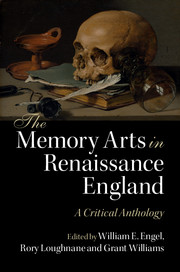Book contents
- Frontmatter
- Dedication
- Contents
- List of figures
- Acknowledgements
- A note on abbreviations
- Introduction
- PART I The art of memory
- PART II Rhetoric and poetics
- PART III Education and science
- PART IV History and philosophy
- PART V Religion and devotion
- Introduction to Part V
- V.1 Thomas More, A Treatise (Unfinished) upon these Words of Holy Scripture (1522)
- V.2 John Foxe, Acts and Monuments (1563)
- V.3 Thomas Playfere, The Pathway to Perfection (1593)
- V.4 Joseph Hall, selected works
- V.5 Richard Day, A Book of Christian Prayers (1608)
- V.6 Daniel Featley, ‘Four Rows of Precious Stones’ (1610)
- V.7 Lewis Bayly, The Practice of Piety (1613)
- V.8 John Donne, ‘Sermon, preached at Lincoln's Inn’ (1649)
- V.9 Stephen Jerome, A Minister's Mite (1650)
- V.10 E.M., Ashrea (1665)
- PART VI Literature
- Index
- References
V.2 - John Foxe, Acts and Monuments (1563)
from PART V - Religion and devotion
Published online by Cambridge University Press: 05 August 2016
- Frontmatter
- Dedication
- Contents
- List of figures
- Acknowledgements
- A note on abbreviations
- Introduction
- PART I The art of memory
- PART II Rhetoric and poetics
- PART III Education and science
- PART IV History and philosophy
- PART V Religion and devotion
- Introduction to Part V
- V.1 Thomas More, A Treatise (Unfinished) upon these Words of Holy Scripture (1522)
- V.2 John Foxe, Acts and Monuments (1563)
- V.3 Thomas Playfere, The Pathway to Perfection (1593)
- V.4 Joseph Hall, selected works
- V.5 Richard Day, A Book of Christian Prayers (1608)
- V.6 Daniel Featley, ‘Four Rows of Precious Stones’ (1610)
- V.7 Lewis Bayly, The Practice of Piety (1613)
- V.8 John Donne, ‘Sermon, preached at Lincoln's Inn’ (1649)
- V.9 Stephen Jerome, A Minister's Mite (1650)
- V.10 E.M., Ashrea (1665)
- PART VI Literature
- Index
- References
Summary
About the author
John Foxe (1516/17–87) left his position at Oxford University because of his Reformed views, and subsequently followed many Protestants into exile during the Marian reign. On the continent, he toiled in the book trade, establishing a community of collaborators, who supplied him with much of the documentation for Acts and Monuments.
About the text
Popularly known as the Book of Martyrs, this lavishly illustrated text was one of the costliest English books to produce or to purchase in the sixteenth century, amounting to 1,800 folio pages in the first edition of 1563. The excerpt below comes from this edition's prefatory matter. Foxe along with the publisher John Day oversaw the printing of the first four editions, each successive edition of which revised and expanded upon the bulk of its predecessor. Foxe is less a conventional author than a compiler, editor and contributor to the massive tome that gathers from various sources the documentary accounts and records of bloody Mary's persecution of England's Protestants. Foxe models his project after that of Eusebius, a fourth-century Bishop of Caesarea, whose Ecclesiastical History, translated into English in 1577, chronicled the Church's growth from its inception to his own time. Foxe's book, second only to the Bible in its importance to English Protestant households, had an institutional presence, for chained copies were installed throughout England in cathedrals, churches, schools, libraries and guildhalls.
The arts of memory
The Book of Martyrs rather spectacularly marks the point at which the textually oriented memorialising of English Protestantism sublates the commemorative function of the saint's life: it both preserves and surmounts Catholic memory, whose devotion towards the miraculous body manifests itself in reliquaries, relics, icons and other venerable objects. Foxe wages a campaign against hagiography, exemplified by the cultural prominence of the Golden Legend, the florilegium of saints’ lives quarried by medieval preachers and widely circulated over the centuries in manuscript and print forms. This storehouse of saint lore captured the popular imagination, not only infusing life into the Church Calendar of Christian feasts but also supplying evocative imagery and scenes for the graphic arts. In Foxe's text, the martyr is not reducible to his body's grisly expiration, but bears witness to the Christian faith through word and deed, remaining true to his doctrinal beliefs in an assured and equanimous manner while suffering under extraordinary duress.
- Type
- Chapter
- Information
- The Memory Arts in Renaissance EnglandA Critical Anthology, pp. 235 - 238Publisher: Cambridge University PressPrint publication year: 2016



